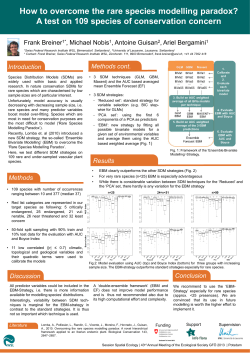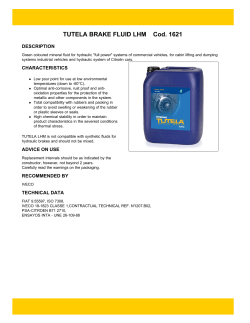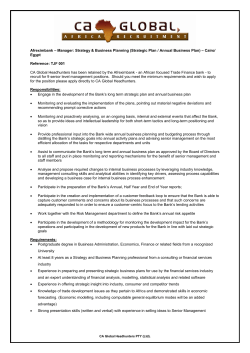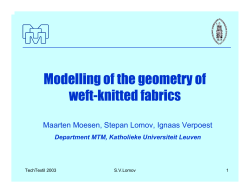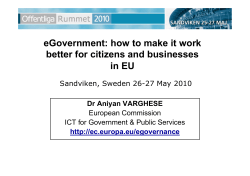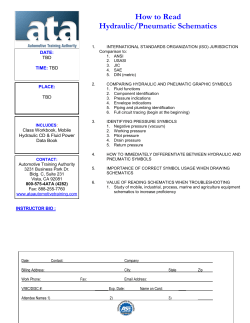
Hydroinformatics in 1999: what is to be done? ABSTRACT
21 © IWA Publishing 1999 Journal of Hydroinformatics | 01.1 | 1999 Hydroinformatics in 1999: what is to be done? Jean A. Cunge and Marc Erlich ABSTRACT Some possible directions of future evolution of hydroinformatics as seen from the recently observed social demand point of view are indicated. Among key issues concerning water resources management, hydroinformatics can contribute by defining a coherent methodological approach for negotiation of the most relevant water-related conflicts. The latter require however equitable access of all stakeholders and parties in conflicting situations to reliable information and objective tools and allowing assessment and evaluation of a family of feasible solutions. Rapidly changing Information and Communications Technologies (in particular Internet applications) will have also their impact on the way water-related industry will use the modelling software and an appropriate experience. Key words Jean A. Cunge International Institute for Infrastructural, Hydraulic and Environmental Engineering, Westvest 7, P.O. Box 3015, 2601 DA Delft, The Netherlands Telephone: +31 15 15 17 15 Fax: +31 15 12 29 21; E-mail: cun@ihe.nl SOGREAH, 6 rue de Lorraine, 38130 Echirolles, France Telephone: +33 4 76 33 42 81 Fax: +33 4 76 33 43 22 E-mail: marc.erlich@sogreah.fr | DSS, future of hydroinformatics, modelling, telematics for environment, water Marc Erlich SOGREAH, 6 rue de Lorraine, 38130 Echirolles, France Telephone: +33 4 76 33 42 81 Fax: +33 4 76 33 43 22 E-mail: marc.erlich@sogreah.fr resources management conflicts, water industry INTRODUCTION This paper is written for the especial benefit of the very large scale, mostly as convenient tools, ‘without Journal of Hydroinformatics and, more specifically, for questions asked’. Market-driven developments are its first issue. The very term hydroinformatics has many applauded (except for the Microsoft anti-trust lawsuit) definitions and covers many ideas, according to who and the creation of hundreds of thousands of new jobs attempts to define it. Nevertheless, there is a consensus thanks to these initiatives provides a positive feedback that hydroinformatics, considered as a technological to the initial momentum. The European approach, as activity, cannot be defined as a ‘hard’ science. To the expressed and shaped by the 3rd, 4th and 5th Framework contrary, it is regarded as a bridge that aims to close Research and Development Programmes funded by the at least several gaps between ‘hard’, water-oriented European Union (EU), is more ‘intellectual’ (or should sciences, technologies and activities on the one hand, we say ‘Cartesian’?). It tries to define general trends and and such ‘soft’ social requirements as sustainable devel- currents, providing an overall profile of the future as opment, legal regulations and political aims on the other. shaped by the new information revolution. It hopes to The concept of citizen-oriented technology develop- lay wider societal bases and to achieve, through more ment, or of information-society technologies (ISTs), has synergy-oriented actions and incentives, a qualitative appeared with more recent intrusions into everybody’s jump integrating new technologies with human activities. life of exponentially growing communication and infor- Applications in the domain of telecommunications, mation technology applications. It is interesting to note television, multimedia educational tools and citizen- that this phenomenon, historically unique in terms of its oriented activities financed by the 4th and 5th EU Frame- acceleration and the speed of its diffusion, is considered work Programmes are typical examples of this more in different ways in Europe and elsewhere, e.g. in the European approach and way of thinking. The applica- USA. The United States is considered more advanced tions are often supply-side or ‘upstream’ conceived, intel- compared with Europe because, in very pragmatic ways, lectually planned and less spontaneous than in the USA, new technologies are adopted, used and applied on a where industry and citizens take and use as such whatever 22 Jean A. Cunge and Marc Erlich | Hydroinformatics in 1999 Journal of Hydroinformatics | 01.1 | 1999 appears on the market without ‘upstream’ changes in their transformed and in what directions, taking account of the behaviours and organisations. fact that it was built originally upon the foundation of Everyday telematics applications oriented towards numerical modelling of hydraulics and hydrological the large public can indeed be directly market driven, in phenomena? And ‘What is to be done in the way of further the American way. They are explicit for the end-user, the developments and applications?’: a question that the consumer, who uses the telephone continually, views hydroinformatics professional community, as well as television every day, buys a computer and links it to the other communities interested in water-related problems, Internet and so on. All this is done quite naturally with- should ask today. We do not have the ambition to supply a out having any knowledge about the technical solutions, credible answer to this question here, and even less the problems and difficulties. These, including the future ambition to influence the future in a serious way. integration of Internet and television and the formation Taking as a departure point our understanding of of a global telecommunications network, are solved by hydroinformatics as driven by end-user requirements, producers and offered in a turnkey fashion by suppliers. Information & Communications Technologies (ICTs) The telematics applications industry knows the end-user applications in the water area (’the proof of the pudding is language and the market; the profit margins are so big that in the eating’), an effort can be useful to try to enumerate to find money for necessary investment and marketing is at least some causes of change, some emerging trends no problem. Governments can never resist very long in the and premises, and some possibilities that are seen today, face of such market forces in Europe just as in the USA. such as: The example of the number of digits allowed in French • water-related conflicts, decision making and • hydroinformatics and industry (water industry, message encryption is eloquent: the French government, evoking national defence interests, resisted less than a year before allowing the total liberalisation of this issue. The domain of water supply, civil-engineering works, planning and project concept and development, is closely related to environmental problems and hence to politics and citizens. Budgeting for these developments in Europe, • hydroinformatics; consulting and contracting companies, software developers): strategy, possible changes and trends; current technical and conceptual developments and trends for the near future. at least, is nearly exclusively administered by governmen- That is the purpose of this paper in which several of these tal agencies and it is very far from being governed by the aspects are discussed. market alone. It is then not surprising that the hydroinformatics concept has been born within this field of activities, and in Europe, because it deals precisely with integration and linking of various domains, the rise of such concepts from conventional market activities alone would be diffi- CONFLICTS, WATER AND HYDROINFORMATICS cult. There is an analogy between this situation and that of It is likely that water-related problems will be in the near computational hydraulics and numerical simulation some future (with a timescale of, say, ten years) the essential and 25–30 years ago, when European advances compared with main source of difficulties and conflicts, all over the world. American civil engineering practice was based on an over- Why water? Because, even if most people do not realise all integrated reflection rather than on the simple appli- the situation today, the scarcity of water will probably cations of market-available tools to traditional methods. become an acute reality to them before the scarcity of oil Nevertheless, the concept of hydroinformatics is spread- or of breathable air. ing rapidly and any novelty is today of very short duration. Current global information network systems see to that! There is a near certainty that several water-problemtriggered, serious political conflicts will occur within a However, there is the question of the near future. short time. It is only a question of where it will begin, but What will become of hydroinformatics: how will it be the locations of focal points in the Middle-East, Africa, 23 Jean A. Cunge and Marc Erlich | Hydroinformatics in 1999 Journal of Hydroinformatics | 01.1 | 1999 South America and Asia are well known to everybody; will make people change their views; and the result in that there is no need to enumerate them. How long will it take case may not necessarily be better than the current ‘do before Clausewitz’s definition of war as ‘politics carried nothing’ attitude. Some years ago in Southern France out with other means’ will become true in the field of during a summer drought, there were two demonstrations water politics and lead to a danger of armed conflicts? within only a 3 week interval: one against a proposed dam However, even without going into even these not-so- (because of its ruining the landscape) and another for the distant futures, one witnesses, on every economic level, a same dam because the summer was very dry and the river continuous procession of political and economic conflicts transformed itself into a stinking sewer killing all fish; a linked to water scarcity and water quality and, sometimes, dam, if built, would at least have maintained a minimum on the other boundary of the scale, of water fury (inunda- discharge. tion, flash floods, etc.). Let us mentioned just a few of these. Agricultural pollution by nitrates and pesticides Financing the structures The degree of pollution of groundwater reserves and the Water systems ask for important investments, and the timescale of the consequences have only begun to be acquisition of the funds necessary for these investments is understood by the population of European countries. The a key problem in the decision process. Funding is para- consciousness of the irremediable catastrophic effects that doxically more and more dependent not so much (or not will be felt during scores of years because of the slow rate only) upon banks but also upon groups of citizens, their of underground water transport only now begins to pen- associations, environmental organisations and other such etrate people’s minds. In France, for instance, we observe bodies. This phenomenon is international and the con- political and violent demonstrations of farmers against flicts over the decision ‘to build or not to build’ are more proposed taxes on water polluters (i.e. fertiliser and and more frequent. The first well-known example is the pesticide users) and, at the same time, for governmental Narmada Dam (in India), a saga continuing over the past financial aid to farms which cultivate biologically ‘clean’ 5 or 7 years: the World Bank, under the pressure of public products rather than the ‘production-efficient’ farms, opinion, attached several conditions of an ‘environmental’ privileged by an EU subvention policy, which use type to its offer to finance the dam. The Indian Govern- pesticides and fertilisers intensively and extensively. ment preferred not to accept the financing rather than change its own views, thus making the financing of the Dams and reservoirs dam more difficult. The expression of ‘citizen power’ in this case was rather crude and went so far as throwing There is no way in France to build a dam, even if the stones at the World Bank’s office windows during demon- purpose is to ensure water supply to the cities or to a strations in Washington, DC. Another case dates from maintain minimum quality in the river downstream, or to March 1999 and concerns the financing of the Three protect the valley against floods. Political conflicts, local Gorges Dam in China. The financing of the second phase and national, over the preservation of existing valley land- of the project comprises several loans from American scapes make the decision process not only continue for banks amounting to a total of around US$ 3,000 million. decades but most often lead to a political deadlock. A Several clients of these banks have declared that they will typical example is the river Loire and its tributaries and close their accounts and change their banks because the the quarrels (which have now lasted for 15 years) over two Chinese project is considered unsound from environ- dams: Chambonchard on the Cher river and Veurdre on mental and social points of view. The banks have the Allier river. It is doubtful that they will ever be built, withdrawn their offer to lend money to finance the Project. unless there occurs an exceptional flood causing so much It goes without saying that on the basis of the known loss of life and so much material damage that sheer terror data there is no way, in all the above-mentioned cases, to 24 Jean A. Cunge and Marc Erlich | Hydroinformatics in 1999 Journal of Hydroinformatics | 01.1 | 1999 Figure 1 | Post-industrial era and sustainable development: to allocate, means to share information and to arbitrate through consensus (Matthews 1996). Figure 2 | To allocate, means to produce information, to be able to forecast consequences of our actions (e.g. pollution) (Matthews 1996). be sure who is right, who is wrong, whose position or decision makers are not only, as was the case 50 years solution is less (or more) acceptable than others, etc. Intui- ago, engineers, but also others, including whole ranges of tively it seems clear that there is no solution satisfactory to citizens and their associative and political emanations as everybody. These situations are summarised in Figures 1–3 well as the information carriers (media). As said above, the (from Matthews 1996) based on the obvious axiom that most dangerous and important conflicts and problems there are two limits as far as water resources are con- within the next 25 years will be those of pollution, environ- cerned: absolute quantity of water resources available on mental quality, and resources scarcity (including water, the planet, and the minimum quantity needed for the but also energy and agriculture). All are in one way or sustainability of acceptable conditions of life on the planet. another water-oriented. It is of capital importance to every Subtraction of the latter from the former gives a stakeholder, to every actor in this play, to understand that limit, not to be crossed by consumption, to satisfy socio- eventually only negotiated solutions are acceptable, even economic requirements. These requirements must be if they cannot be completely satisfactory for all involved. modified simply because the available resource is limited We are in the situation where the rules of allocation of and variable in time: it can decrease because of human limited resources under constraints are sought. Thus, activities (e.g. agricultural pollution of groundwater) or if armed solution is excluded, for every specific situation because of climatic constraints (e.g. droughts). the stakeholders, willy-nilly, will have to search for a There is a necessity to share a limited resource. In such a situation, if things are left to their own, conflicts (local, global, political, social, violent, etc.) can only multiply until we cross the border of sustainability, engage in quasi-religious wars of extermination, or are forced to compromise. DECISION MAKERS, OBJECTIVE TOOLS, HYDROINFORMATICS Thus, when water problems are concerned, we are living in a conflicting world where the stakeholders, players and Figure 3 | To allocate scarcity, means to share information (Matthews 1996). 25 Jean A. Cunge and Marc Erlich | Hydroinformatics in 1999 Journal of Hydroinformatics | 01.1 | 1999 compromise solution. And, once the choice of a solution is made from several possible solutions, its implementation has to be done as an engineering solution because that is the traditional purpose of engineers: to build, to implement, to organise workable structures and solutions which are ad minima satisfactory to meet social requirements within the available budget. A rational search, if not for consensus then at least for compromise, is difficult to imagine without two conditions: 1. Elaboration and presentation to all interested parties of the information, so as to share information in an equitable way, i.e. so that it is identical in content and intelligible to all parties – a task impossible Figure 4 | ‘Loop of Consensus’: ISMAP/EUREKA Project. without objective tools. 2. Use of objective tools (methodologies, processes) allowing for the confrontation of consequences of various potentially possible scenarios and solutions as well as for an iterative approach of the final choice. 1998). That means that all concerned regard the outputs of the tool as valid consequences of the inputs, whatever are At this stage it is necessary to explicate the terminology. the inputs, the latter representing hypotheses proposed by Let us stress the difference between data and information. stakeholders. This ‘tool’ can be ‘immaterial’, e.g. a meth- The data may be collected in the field (e.g. measurements odology, or a model, or a data and information processing of physical quantities such as water level, degree of pollu- system. The essential point is that its credibility be tion, etc.); satellite imagery, optical or radar, are also data, accepted by all concerned. Thus if an output (e.g. the although of a different kind; state variables defining eco- degree of groundwater pollution) is unacceptable to a system or biodiversity, their evolution, location of houses, stakeholder, it means that for him or her the correspond- regulations and laws – all are data that can be measured or ing input hypothesis (e.g. quantity of pesticide per area) is collected in the field or which may result from projec- unacceptable. Such a tool allows negotiations based on tions, extrapolations and modelling. The information is merit, not on passion – it is an essential link in a loop of elaborated from the data under a form that should be consensus as shown in Figure 4, supposing that consensus intelligible to the stakeholders. If the information is to is possible. provide an equitable basis for seeking a consensus, it must Obviously, the only way to arrive at such a situation is be supplied under the same form for all stakeholders and to involve all those concerned in the development of must be considered by all of them as objective. That means requirements for the tool in the development of the tool that the tools and the ways in which the data is fused and itself and in its validation. And, as mentioned above, the transformed into the information must not be partial, sub- presentation of the information in a form that is equitable, jective, suspected by some stakeholders: there is a need for intelligible and identical for all concerned is an essential objective ‘data→information’ transformation tools. point in this ‘objective’ approach. The most obvious and An objective tool (modelling software, risk manage- practically proven way to develop such ‘objective’ tools is ment system, knowledge base and its content, information to finance and control such developments by a common system, communication network) is a tool that is con- investment effort by the interested stockholders. The sidered by all concerned stockholders as valid (Cunge example of the French–Italian–British EUREKA–ISMAP 26 Jean A. Cunge and Marc Erlich | Hydroinformatics in 1999 Journal of Hydroinformatics | 01.1 | 1999 project (Aboujaoude´ et al. 1994) is instructive: governmental funds covered roughly 40% costs, while the other 60% came directly from the stakeholders. The latter included fertiliser and pesticide manufacturers, the Vivendi (former Compagnie Ge´ne´rale des Eaux), which must clean water polluted by these products, French Basin Agencies, who tax the polluters and finance water cleaning, farmer associations, etc. The development was done by independent consultants and controlled by a steering and a scientific committee composed of the stakeholders. The result was that after a first stormy period of co-operation there was unanimous agreement that the developed Figure 5 | Encapsulation principles for large size sewer network management systems. tools were objective and could be used to seek overall consensus concerning this application. What now is the reason why hydroinformatics can and It is difficult, maybe impossible, even to sketch the should play an essential role in building and applying such more distant future of hydroinformatics. It is interesting, tools and not, for example, ICTs alone? It is because in a however, to describe the tendencies and certain obvious conflicting world it is of the utmost importance to have an directions that are being taken by some of components of end-user oriented approach to be able to construct inter- what we call today hydroinformatics activities. faces between the technology (which is unintelligible to most of the end-users) and the end-users (stakeholders) themselves. The word interface means here the capacity to understand the end-user problems, to be credited by the stakeholders with good technical understanding of the problems and with the capacity to assess the technical MODELLING, WATER-RELATED INDUSTRY CONSULTING, AND HYDROINFORMATICS feasibility (not a preference!) of the proposed solutions. Hydroinformatics has been built around and upon And hydroinformatics is precisely such an activity: simply hydraulics and hydrology, and at its heart was numerical to apply ICT tools to existing hydraulics and hydrological modelling and computational hydraulics. It is because of methods would not satisfy at all the basic requirements its links and interwoven developments with ICT that it that come into play here. The decision makers are today widened its horizons and perspectives, building bridges politicians, elected bodies, media, public opinion, associ- towards biological and social sciences but, first of all, ations, etc. But whatever they decide and whenever we towards water industrial and water resources manage- talk about the water-related realm, the engineers are sup- ment. The current positions of hydraulics and hydrology posed to carry out their decisions. Hydroinformatics (including their modelling software) is most often that of should seize the chance and the leading role because of supplying the results of modelling to larger water industry its particular position, because of its experience of ICT systems (such as water supply or wastewater, sewerage tools applied to numerical modelling, thanks to its links systems) or to carry out nearly standard calculation pro- with hydraulics and hydrology and to engineering cedures used or subcontracted by civil and engineering- and because of its expertise in water problems. If works contractors. One of the possible futures is that hydroinformatics-oriented institutes and companies do hydraulics/hydrology not show the way, somebody else will appear to do some- become parts of the larger management systems. Figure 5 thing that outwardly resembles hydroinformatics simply schematises the place of these technologies and scientific- because there is such an obvious historical, material and related activities in large urban water industry systems and social set of requirements for such an activity. it is obvious that their financial or administrative weights encapsulated components will 27 Jean A. Cunge and Marc Erlich | Hydroinformatics in 1999 Journal of Hydroinformatics | 01.1 | 1999 are negligible compared with the whole. They are becoming more and more encapsulated and used as components of a puzzle. This situation has already been pointed out several years ago (Cunge 1997) and since then the trend has continued. The qualities of hydraulic modelling and of the hydrological aspects are of utmost importance to the success of the perennial functioning of whole systems. Consider such problems as the recirculation of warm (or cold) outfall water, pollutant dilution, and estimates of the project flood discharges necessary to define evacuators. It Figure 6 | Past evolution. is easy to realise that if errors are made at that level, whole systems, whatever their cost and complexity, might well lose their usefulness. Nevertheless this situation does not seem to trouble the decision makers or contractors, mostly hydroinformatics and modelling, three categories or streams because they do not understand this risk and, in the of company and institute, as shown in Figure 6: absence of an evaluation of uncertainty and error margins, they assess the risk exclusively in terms of the cost of • the hydraulic/hydrology component, which of course is ent order of magnitude than usually assessed. Because • of this, the consciousness that interfaces (in the sense developed and made available to the public. It must also be mentioned that the bridge could have been an environmental failure without new progresses in modelling which consulting companies having a specific expertise in the field of applications of hydroinformatics tools, studies as well as for advising the water industry, later—either in the wake of technical failures or as conse- never have been built if such interfaces had not been hydroinformatics; employing this expertise for their own projects and defined above) are necessary will emerge sooner or quence of political processes. A forerunner example is the ¨ resund bridge and tunnel in Denmark, which would O ‘standard’ market-available tools without particular ambition to acquire an expertise in the field of negligible compared with the whole system or structure. The importance of the problem is real and of a differ- ‘traditional’ consulting companies employing • contractors and the former stream of companies ; consulting companies and institutes who are also developers of hydroinformatics and modelling software, the latter being put on the market and made commercially available to the two previous streams. were in turn prompted by the need to develop general This emergence of the three categories is not accidental. citizen-oriented interfaces. The reasons are market-driven. Within the population of One possibility is that such interfaces will be devel- developers–consultants existing at the end of the 1980s oped by the water industry, in which case independent and the beginning of the 1990s, a differentiation developers of hydroinformatics software systems as well occurred, mainly because of strategic decisions made as expert consulting activities on this field might dis- and applied by some consulting companies and then appear, absorbed by water industry companies. Another consolidated possibility is that these interfaces will be developed by others to find the funds necessary to be invested to modelling software suppliers through hydroinformatics catch-up. activities, which have their origins in water-consulting engineering activities. by the difficulty (impossibility?) for This trend is being favoured by the emergence of electronic commerce through the Internet: a consultant As far as the consulting water-related industry is will now be able to buy through the network the software concerned one can distinguish today, with respect to and modelling services she or he needs for a specific 28 Jean A. Cunge and Marc Erlich | Hydroinformatics in 1999 Journal of Hydroinformatics | 01.1 | 1999 for the client and end-user. This ‘tool user’ must of course know the basic algorithms and limits of market-available hydroinformatics tools, but does not need to develop them in-house. But, then, this user still has a privileged position in advising civil engineering contractors and the water industry, because there are no links with the tool makers. Indeed, at that point one should not forget the contracting and civil works industry which essentially is and will be a user of hydroinformatics and modelling systems, Figure 7 | either market-available or customised. However, when Likely future evolution. important projects or the updating of their own systems are concerned, this industry needs the advice and expertise coming from the consultants, independently of the project from a developer (and also to buy on the net- developers, i.e. of companies belonging to the second or work) for the same project modelling services and/or the third streams. advice and expertise from a consultant categorised in the second stream (as is being tested in the framework of EC ESPRIT programme ELTRAMOS project (ELTRAMOS 1998)). This will make it easier for the first stream companies to avoid errors and misapplications due to their limited expertise in modelling but, at the CURRENT AND NEAR-FUTURE TECHNICAL DEVELOPMENTS AND APPLICATIONS same time, it will make the fences between the streams We shall limit ourselves only to a very few examples, even higher and stronger. without even pretending to give a representative sample of The situation described is new. Traditionally it was what can be expected or of what is going on. The examples thought that there was no room for the ‘second stream’. are purposefully taken from domains linked very much to Obviously, it can be strategically more ‘noble’ to be both a the more traditional activities of consultants, managers, developer and a consultant – modelling expert than to be modellers and hydraulics/hydrology software developers – the latter only. This, however, is not possible for all. If a to show that new applications and developments of company has not such a position today, the investments these activities are to be expected from the spread of necessary hydroinformatics activities. to catch up with existing development capacities are so great that in practice no outsider can dream of it. It is known, moreover, that profit margins in the business are rather narrow and if such investments were made today a positive return on them would be doubtful (Figure 7). Data mining and information We are at the very beginning of the era of data mining, the On the other hand, there is no need today for a technique that exists both in the search for data and consultant to be a developer, to be an expert in modelling. transformation of data to knowledge and which is seen as The qualifications and level of expertise depend on a the step that performs knowledge discovery (Fayyad et al. focusing on the basic trade (e.g. water-orientated engin- 1996). The data are today raw and abundant resources, not eering, structures, applications) and knowledge of how to exploited because of a lack of tools, a lack of the means to apply tools from various origins, how to choose them as transform them into information and a lack of a developed functions of the physical and engineering problems at market. Although the highly successful businesses built hand, how to interpret the results and how to create around Internet search engines (e.g. Yahoo!) are available appropriate information, based on the modelling results, today, still, searching for data is at the low/primitive end 29 Jean A. Cunge and Marc Erlich | Hydroinformatics in 1999 Journal of Hydroinformatics | 01.1 | 1999 Applications for Environment Sector of the European (a) Commission’s 4th Work Programme (EC/DGXIII, Catalogue of TA ENV Projects, 1998). Another example is the D2K project (http://projects.dhi.dk/d2k), currently the only large-scale data mining effort in hydroinformatics. There are also scientific numerical methods that can be considered as basic tools for systems: new generations of Artificial Neural Networks (ANNs) tools, Evolutionary Algorithms (EAs) method approaches allowing for recovery of the form of physical laws from the raw data, etc. They have been already applied in water related problems (Babovic & Abbott 1997a, b). (b) Risk and emergency management systems When trying to perceive current technical trends of hydroinformatics there are two interesting components of such systems: modelling-forecasting and information systems for the management of emergency situations. Modelling–forecasting of floods seems to be one of the essential components for the management of risks and Figure 8 | (a) Petroleum in 19th century; (b) information today: raw resource of constantly increasing availability and decreasing cost. emergencies, but although scientifically and technically the problem can be considered as solved, operational on-site implementation encounters a resistance that hampers the seriously potential benefits of such progress. It is impossible to make a useful real-time flood forecast of the products (search engines provide only where data without appropriate simulation models. If the credible are to be found, but they say nothing about its relevance, lead-time for a quantitative forecast of the rainfall is nor do they provide any sort of interpretation). As shown limited to something like one hour, there are tools to in Figure 8a, b, one can compare the situation to the one of forecast the evolution of flows and levels in rivers as well petroleum at the beginning of 19th century, with possible as those at the outlets of watersheds due directly to similar economic consequences, but most likely within a the rainfall/runoff transformation. Model simulation is much shorter span of time. always marked by uncertainties in the knowledge of Important to us is the emergence, even in an embry- local physical characteristics, evaluation of experimental onic form, of tools for exploiting the existing veins of data, coefficients, etc. Some methods or models may be better which are already available as databases and information adapted to the local situations than others, e.g. in different sources. What is needed is to transform these data into winter- and summer-season models, or even different information. Once the data are interpreted, one can hope methods might be used with better results than when using for a serious pay-off (both scientific and commercial). one method for both. Another element is subjective: some Refined knowledge is more valuable than raw material forecasters interpret the simulation results of some models (data). There are some first experimental systems able to with more success than the results of others, while some look for the data and transform them, such as developed decision makers and engineers are for various reasons in the E-MAIL and REMSSBOT Projects of the Telematics ‘model patriotic’ and would accept only ‘their’ models. A 30 Jean A. Cunge and Marc Erlich | Hydroinformatics in 1999 Journal of Hydroinformatics | 01.1 | 1999 typical hydroinformatics approach to this problem is to develop ‘multi-method, multi-model’ systems allowing a hydraulic engineer or a hydrologist to choose a method, to choose the necessary data within a database and to build, in a user friendly way, several ensembles of models for a watershed and a river. These ensembles can then be used in operational real-time forecasting. The concept is that of an object oriented architecture of the system, the objects being methods, data sets, calibrated models and ensembles of models. For instance, such a system was developed and operationally implemented first on two important sites in China (Cunge et al. 1994; Rahuel et al. 1996) within the framework of industrial co-operation between China and the Commission of the European Communities (DGXIII, Figure 9 | General control loop of water management. Information and Communication technologies). Afterwards, a very limited number of applications were done in France. This novel concept will most likely transform itself into a new generation of systems: instead of object oriented architectural elements, which are connected by fixed interfaces, a new concept of multi-model multimethod systems having an object-oriented architecture the elements of which are dynamically linked by intelligent software agents is being born (Babovic 1991, 1996; Woolridge and Jennings 1994) and, more recently, a new approach to distributed decision support, which makes which originates from remote and terrestrial sources. And then through the transmission of the results in graphical form superimposed upon GIS implemented on the portable mobile equipment of the emergency teams. The information is to be also made available in a transparent way to the citizens. The existence of such systems will make it possible to train emergency teams and to prepare citizens for a possibility of emergency during a crisis preparation phase. use of intelligent agents on the computer networks such as the Internet (Velickov & Price, personal communication 1999). And this is the real news: here is a potential trend (Figure 9). Network management systems From a hydrodynamics point of view there are essentially Efficient information systems for the management of two types of network that should, in the very short term, emergency flood situations are in their childhood today; benefit from real-time operation using emergent methods they are almost non-existent. The reason for this is that and approaches: water supply networks and, most im- the monitoring–forecasting part of the management is not portantly, storm sewer networks. Both water quantity integrated with emergency management on the terrain. (discharges) and water quality are concerned. Ideally the rescue and other terrain management oper- The storm sewer network problem is important ational teams should have been supplied in real-time with because of the short duration of events. The reactions maps of current and future (in 1, 2, 3, 6, 12 hours) inunda- must be very rapid (within 5 minutes from reception of tion situations as well as all other information concerning information), the lead time is of the order of 30 minutes, the evolution of the menace. Today they have nothing of the update of information every 10–15 minutes. Like the kind (except in catastrophe film fiction). The necessary flash flood real-time forecasting, deterministic models picture and efficiency can come only through the fusion developed during the 1980s and 1990s most often do and synthesis (i.e. transformation into intelligible informa- not allow the consideration of all hypotheses and risks. tion) of all quantitative and qualitative available data A new approach (such as represented on Figure 5) that is 31 Jean A. Cunge and Marc Erlich | Hydroinformatics in 1999 potentially prone to spread in practical applications is a scenario-based management approach (Auriaux et al. 1996; Erlich 1996) which is implemented already at a few sites and which is most interesting because it allows for taking into account several hypotheses, not just one. On the other hand automatic control, and control and optimisation approaches and methods are being developed and no doubt will be applied, primarily because of systematic decreases in computing costs and increases in the speed of computing equipment. CONCLUSION We are living in interesting times and hydroinformatics, understood as an activity bridging the gaps between various domains, either strictly water- or citizen-oriented, or both, has a promising future in the service of social requirements. REFERENCES Aboujaoude´, A., Cabal, A., Chaillet, P. & Sauvaget, P. 1994 Some new concepts of hydroinformatics systems. J. Hydraulic Research 32 (no. 3, extra issue ‘Hydroinformatics’), 137–152. Auriaux, G., Erlich, M. & Cabal, A. 1996 Design and implementation of an hydraulic scenarios data base for a real-time management of a sewer network. In Hydroinformatics ’96, (ed. Muller, A.), pp. 157–164. Balkema, Rotterdam. Babovic, V. 1991 Applied Hydroinformatics: A Control and Advisory System for Real-Time Applications, IHE Report Series 26, Delft, The Netherlands. Babovic, V. 1996 Emergence, Evolution, Intelligence; Hydroinformatics. Balkema, Rotterdam. Journal of Hydroinformatics | 01.1 | 1999 Babovic, V. & Abbott, M. B. 1997a Evolution of equation from hydraulic data: Part I – Theory. J. Hydraulic Research 35 (3), 1–14. Babovic, V. & Abbott, M. B. 1997b Evolution of equation from hydraulic data: Part II – Applications. J. Hydraulic Research 35 (3), 15–34. Cunge, J. A. 1997 Invited Lecture, International Conference Bauforum, Berlin. Cunge, J. A. 1998 From hydraulics to hydroinformatics (keynote lecture). In Advances in Hydro-Science and -Engineering, Volume III, Proc. 3rd Int. Conf. on Hydroscience and Engineering, Aug. 30–Sept. 6, Cottbus, Germany. Cunge, J. A., Erlich, M. & Rahuel, J. L. 1994 Towards scenario-based real-time forecasting for flood-affected basins using a multimodel integrated system. In Proceedings of 2nd International Conference on River Flood Hydraulics (ed. White, W. R. & Watts, J.), chapter 2, Flood Forecasting, pp. 77–91. Wiley, Chichester, UK. ELTRAMOS, 1998 Electronic Market and Trading of Modelling Services and assets for engineering SMEs and institutes, ESPRIT, Industrial R&D Electronic Commerce Project N° 26700, E-COMM Catalogue, EC/DG XIII, June 1998. Erlich, M. 1996 Feasibility of the supervision and steering on a storm drainage system through rainfall scenarios recognition. In Proc. 7th IAHR International Symposium Stochastic Hydraulics ’96 (ed. Tickle, K. S. et al.), pp. 395–402. Balkema, Rotterdam. Fayyad, U., Piatetsky-Shapiro, G. & Smyth, P. 1996 From data mining to knowledge discovery: an overview. In Advances in Knowledge Discovery and Data Mining (ed. Fayyad, U., Piatetsky-Shapiro, G., Smyth, P. & Uthurusamy, R.), pp. 1–36. MIT Press, Cambridge, Mass. Matthews, G. 1996 Key-note lecture, Seminar organised by the Science and Technology Commission of Shanghai Municipality and European Commission at the end of the Co-operation Project Data Transmission and Processing for the Shanghai Flood DSS, Shanghai, People’s Republic of China, June 1996. Rahuel, J. L., Erlich, M. & Chaillet, P. 1996 Mode´lisation du syste`me hydrographique du delta du Yangtze pour la pre´vision ope´rationnelle des inondations de Shanghaı¨, 24e`me Journe´es de l’Hydraulique, 18–20 Septembre 1996, Paris, SHF. Velickov, S. & Price, R. K. 1999 Personal communication. IHE, Westvest 7, P.O. Box 3015, 2601 Delft, The Netherlands. Wooldridge, M. J. & Jennings, N. R. (eds) 1994 Intelligent Agents – Theories, Architecturea and Languages. Springer-Verlag.
© Copyright 2025
